MainStage User Guide
- Welcome
-
- Overview of Edit mode
-
- Select patches and sets in the Patch List
- Copy, paste, and delete patches
- Reorder and move patches in the Patch List
- Add patches
- Create a patch from several patches
-
- Overview of the Patch Settings Inspector
- Select patch settings in the Patch Library
- Set the time signature for patches
- Change the tempo when you select a patch
- Set program change and bank numbers
- Defer patch changes
- Instantly silence the previous patch
- Change patch icons
- Transpose the pitch of incoming notes for a patch
- Change the tuning for a patch
- Add text notes to a patch
-
- Overview of channel strips
- Add a channel strip
- Change a channel strip setting
- Configure channel strip components
- Show signal flow channel strips
- Hide the metronome channel strip
- Create an alias of a channel strip
- Add a patch bus
- Set channel strip pan or balance positions
- Set channel strip volume levels
- Mute and solo channel strips
- Use multiple instrument outputs
- Use external MIDI instruments
- Reorganize channel strips
- Delete channel strips
-
- Overview of the Channel Strip Inspector
- Choose channel strip settings
- Rename channel strips
- Change channel strip colors
- Change channel strip icons
- Use feedback protection with channel strips
- Set keyboard input for a software instrument channel strip
- Transpose individual software instruments
- Filter MIDI messages
- Scale channel strip velocity
- Set channel strips to ignore Hermode tuning
- Override concert- and set-level key ranges
- Add text notes to a channel strip in the Channel Strip Inspector
- Route audio via send effects
-
- Screen Control Inspector overview
- Replace parameter labels
- Choose custom colors for screen controls
- Change background or grouped screen control appearance
- Set screen controls to show the hardware value
- Set parameter change behavior for screen controls
- Set hardware matching behavior for screen controls
- Reset and compare changes to a patch
- Override concert- and set-level mappings
-
- Overview of mapping screen controls
- Map to channel strip and plug-in parameters
- Map screen controls to actions
- Map a screen control to multiple parameters
- Use screen controls to display PDF document pages
- Edit the saved value for a mapped parameter
- Set drum pads or buttons to use note velocity
- Map screen controls to all channel strips in a patch
- Undo screen control parameter mappings
- Remove screen control mappings
- Work with graphs
- Create controller transforms
- Share patches and sets between concerts
- Record the audio output of a concert
-
- Overview of concerts
- Create a concert
- Open and close concerts
- Save concerts
- How saving affects parameter values
- Clean up concerts
- Consolidate assets in a concert
- Rename the current concert
-
- Overview of the Concert Settings Inspector
- Set MIDI Routing to channel strips
- Transpose incoming note pitch for a concert
- Define the program change message source
- Send unused program changes to channel strips
- Set the time signature for a concert
- Change the tuning for a concert
- Set the pan law for a concert
- Add text notes to a concert
- Control the metronome
- Silence MIDI notes
- Mute audio output
-
- Layout mode overview
-
- Screen control parameter editing overview
- Lift and stamp screen control parameters
- Reset screen control parameters
- Common screen control parameters
- Keyboard screen control parameters
- MIDI activity screen control parameters
- Drum pad screen control parameters
- Waveform screen control parameters
- Selector screen control parameters
- Text screen control parameters
- Background screen control parameters
- How MainStage passes through MIDI messages
- Export and import layouts
- Change the aspect ratio of a layout
-
- Before performing live
- Use Perform mode
- Screen controls in performance
- Tempo changes during performance
- Tips for performing with keyboard controllers
- Tips for performing with guitars and other instruments
- Tune guitars and other instruments with the Tuner
- The Playback plug-in in performance
- Record your performances
- After the performance
- Tips for complex hardware setups
-
- Overview of keyboard shortcuts and command sets
-
- Concerts and layouts keyboard shortcuts
- Patches and sets (Edit mode) keyboard shortcuts
- Editing keyboard shortcuts
- Actions keyboard shortcuts
- Parameter mapping (Edit mode) keyboard shortcuts
- Channel strips (Edit mode) keyboard shortcuts
- Screen controls (Layout mode) keyboard shortcuts
- Perform in Full Screen keyboard shortcuts
- Window and view keyboard shortcuts
- Help and support keyboard shortcuts
-
- Effects overview
-
- Use MIDI plug-ins
-
- Arpeggiator overview
- Arpeggiator control parameters
- Note order parameters overview
- Note order variations
- Note order inversions
- Arpeggiator pattern parameters overview
- Use Live mode
- Use Grid mode
- Arpeggiator options parameters
- Arpeggiator keyboard parameters
- Use keyboard parameters
- Assign controllers
- Modifier controls
- Note Repeater controls
- Randomizer controls
-
- Use the Scripter
- Use the Script Editor
- Scripter API overview
- MIDI processing functions overview
- HandleMIDI function
- ProcessMIDI function
- GetParameter function
- SetParameter function
- ParameterChanged function
- Reset function
- JavaScript objects overview
- Use the JavaScript Event object
- Use the JavaScript TimingInfo object
- Use the Trace object
- Use the MIDI event beatPos property
- Use the JavaScript MIDI object
- Create Scripter controls
- Transposer MIDI plug-in controls
-
- Instruments introduction
-
- Alchemy overview
- Alchemy interface overview
- Alchemy Name bar
- Alchemy file locations
-
- Alchemy source overview
- Source master controls
- Import browser
- Source subpage controls
- Source filter controls
- Source filter use tips
- Source elements overview
- Additive element controls
- Additive element effects
- Spectral element controls
- Spectral element effects
- Pitch correction controls
- Formant filter controls
- Granular element controls
- Sampler element controls
- VA element controls
- Source modulations
- Morph controls
- Alchemy master voice section
- Alchemy Extended parameters
-
- Playback plug-in overview
- Add a Playback plug-in
- Playback interface
- Use the Playback waveform display
- Playback transport and function buttons
- Playback information display
- Playback Sync, Snap To, and Play From parameters
- Use the Playback group functions
- Use the Playback Action menu and File field
- Use markers with the Playback plug-in
-
- Sculpture overview
- Sculpture interface
- Global parameters
- Amplitude envelope parameters
- Use the Waveshaper
- Filter parameters
- Output parameters
- Define MIDI controllers
- Extended parameters
-

Create Ultrabeat snare drums in MainStage
The sound of an acoustic snare drum consists primarily of two sound components: the sound of the drum itself and the buzzing of the snare springs. Try to approximate this combination in Ultrabeat with a single oscillator and the noise generator. Follow the tutorials sequentially to get the most from these examples.
Create a basic snare drum
In MainStage, load the Standard Tutorial setting.Turn off oscillator 1, and turn on oscillator 2 (in phase oscillator mode).
Choose LFO 1 from the mod pop-up menu of Osc 2 Pitch.
Set the pitch value for Osc 2 to around G#2 and set the Mod amount (the blue Mod control) to about 3 to 4 octaves higher.
You have modulated Osc 2 Pitch with a rapidly vibrating LFO with a medium Ramp Decay value. This eliminates the sine wave—which is not especially desirable for a snare sound, in contrast to the bass drum.
Set LFO 1 to a high Rate. Choose a value of 20 for Cycles and −20 for Ramp. Set the LFO Waveform parameter to a value of about 0.58, which is a square wave.
Use Env 1 to control the volume of oscillator 2 by setting Vol to the lowest possible value (−60 dB), choosing Env 1 from the mod pop-up menu, and adjusting the modulation intensity to a point just below its maximum value.
The figure shows the settings of oscillator 2 and Env 1.

Experiment with different Slope and Asym values to impart a more or less electronic character to the sound.
Turn on the noise generator and control its volume with the same quick envelope used in Osc 2 Volume.
Use the filter parameters of the noise generator to roughen up, refine, or add bright frequencies to the noise component of the snare drum sound. Select an LP filter type, and try a filter frequency between 0.60 and 0.90. Modulate it with LFO 1, which you’re already using to control the pitch of oscillator 2.
Note: The snare drum sound is listed as “snare 1” in the Tutorial Kit, at a pitch of E1.
Refine the snare drum sound using FM synthesis
In MainStage, turn on oscillator 1 in FM mode. Use Env 1 to control the volume of Osc 1 as well.
Choose a pitch for oscillator 1 that’s about an octave lower than oscillator 2. Consciously avoid even intervals between the oscillators and detune them slightly from each other. For example, try a pitch setting of F#2 in Osc 2 and E1 in Osc 1, then fine-tune Osc 1 a few cents higher by holding down Shift while adjusting the Osc 1 Pitch slider.
Experiment with FM Amount, and add more tone (low FM Amount) or noise (more FM Amount) as desired. Also try modulating the FM Amount with a fast LFO.
Higher FM Amount values lead to considerably more overtones and a very electronic sound character. If you want to make the sound more acoustic, feed oscillator 1 (and possibly oscillator 2 as well) into the main filter. Use these settings to start: LP 24 mode and a Cutoff value of about 0.60.
Note: An exemplary snare drum sound that uses FM can be found in the Tutorial Kit at a pitch of F1. It is listed as “snare 2.”
Recreate the 808 snare sound
The famous 808 snare is based on two resonating filters and a noise generator, fed through a highpass filter. The mix ratio of the two filters and the volume of the noise generator can be adjusted. This structure cannot be 100% replicated in Ultrabeat.
In MainStage, load the Standard Tutorial setting.
You are now ready to replicate the resonating filters of the 808 snare using two cleverly programmed phase oscillators.
Assign slightly different Slope values to two phase oscillators, and detune them by almost an octave.
Adjust the tonal relationship between the oscillators so that it is uneven—from E3 to F2, for example.
Control the volume of each oscillator with a different envelope. Adjust the decay times so that the envelope for the lower-tuned oscillator has a longer decay time than the very snappy envelope setting for the higher oscillator.
Feed the output of both oscillators into the main filter, and hollow out the sound with a highpass filter. Activate the filter bypass button in both oscillators. Choose the HP 12 setting in the filter, a Cutoff value around 0.40, and a Resonance value of about 0.70.
You have just cleverly emulated both of the TR-808 resonating filters. Shifting the pitch of both oscillators simulates the behavior of the TR-808 Tone control.
Complete the 808 emulation by adding some noise
In MainStage, switch the noise generator on, and activate the highpass mode in its filter (HP).
Set the Cutoff value to about 0.65, Resonance to 0.35, and add a little Dirt (around 0.06).
The noise generator provides the sustained snare sound. It should be shaped by its own envelope—independent of the decay phases of both oscillators—to get 808-like results. Changing the volume of the noise generator simulates the snap parameter of the 808.
Note: The 808 snare drum described is listed as “snare 3-808” in the Tutorial Kit, at a pitch of F#1. It also features an interesting EQ setting.
Use velocity modulation on your 808 snare
Use the 808 snare drum sounds in the Tutorial Kit to explore the possibilities Ultrabeat offers for implementing velocity.
In MainStage, select the “snare 3-808” sound.
Choose Vel from the via pop-up menu below the oscillator 1 Volume knob.
A slider appears on the ring around the knob.
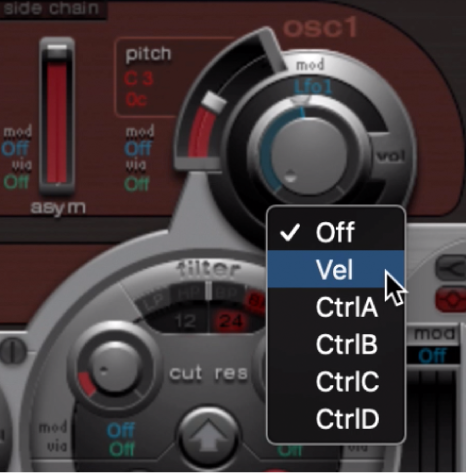
Drag the slider clockwise. When you drag the slider, a help tag displays the value. Set it to 0 dB.
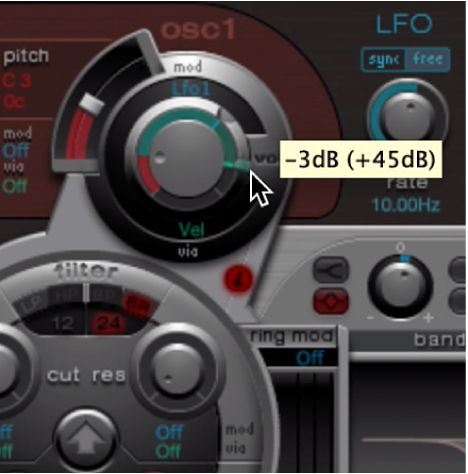
Repeat steps 2 and 3 in both oscillator 2 and the noise generator.
You can now dynamically play the sound using velocity.
Increase the performance dynamics of your 808 snare
In MainStage Ultrabeat, reduce the values of the individual volumes by turning down the Volume knobs in both oscillators and the noise generator. Note how the mod ring and its via sliders also move back. Change the via slider positions until all three Volume knobs look like this:
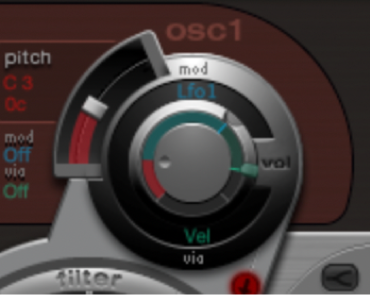
If you use differing intensities for each Volume knob when completing this step, you’ll have the potential of individual velocity reactions for each sound component.
Increase the dynamics of the sound as a whole by assigning the following setting to the Voice Volume knob:
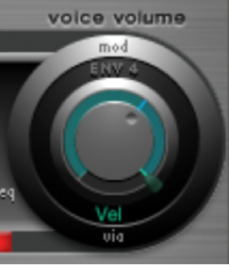
You now have an 808 snare that is exceptionally responsive to velocity. As you may know, this wasn’t possible with the original—not even an 808 sample could offer the dynamic volume control of individual sound components demonstrated here. A sample offers you only the whole sound, not its constituent parts.
In the next step, you use velocity to control the character of the sound—individually for each component—plus volume, of course.
Choose Max from the saturation mod pop-up menu of oscillator 2, and then choose Vel(ocity) from the corresponding via pop-up menu.
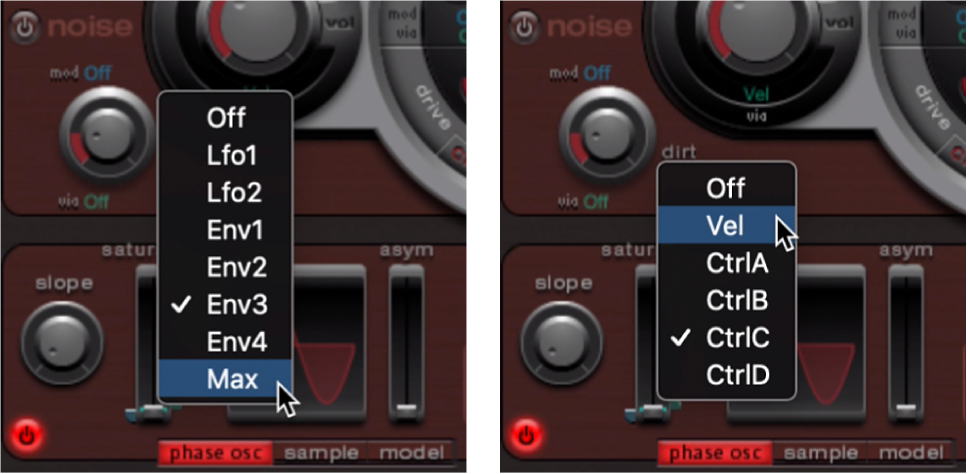
Set the additional control that appears as shown in the figure below, to control the character of the sound with velocity:

Repeat this with the other parameters of oscillator 2, as well as pitch:
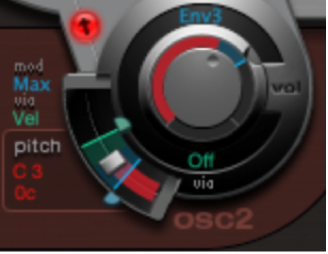
Modulate the noise generator as follows:
Cut parameter: Choose Max as modulation source, then set the modulation control as shown below.
Dirt parameter: Choose LFO 2 as modulation source, then set the modulation control as shown below.
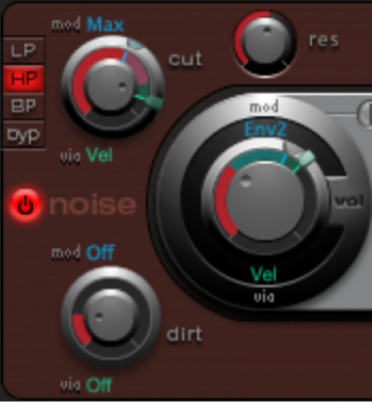
The sound is now nothing like an 808 snare, which was your goal. Keep experimenting with velocity and figure out when it makes sense to use it as a direct or indirect modulation source, in either its positive or negative form.
Recreate the Kraftwerk snare sound
Another classic electronic snare drum sound is the highly resonant lowpass filter of an analog synthesizer that quickly closes with a snap. This sound was used extensively by Kraftwerk.
In MainStage, select the Snare 1 sound.
Direct the signals of both oscillators and the noise generator to the main filter.
Modulate Cutoff with Env 1 (which is already modulating the volume of the noise generator).
Modulate the filter resonance with Env 2.
Experiment with the parameters mentioned in steps 2 to 4 (especially the envelopes), introduce EQ into the sound, and discover how much “playing room” these basic settings allow you.
Note: An exemplary sound is listed as “snare 5-KW” in the Tutorial Kit, at a pitch of G#1. Analyze this sound, and compare it to your own creation.
Download the guides:
MainStage User Guide: Apple Books | PDF
MainStage Instruments: Apple Books | PDF
MainStage Effects: Apple Books | PDF